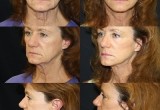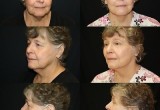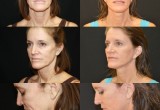Facelift
As people age, the effects of gravity, exposure to the sun, and the stresses of daily life alter their faces. Deep creases form between the nose and mouth, the jawline develops jowls, and fat deposits appear around the neck. A facelift (rhytidectomy) cannot stop the aging process. What it can do is "set back the clock," improving the most visible signs of aging by removing excess fat, tightening underlying muscles, and redraping the skin of your face and neck. Surgery counteracts the affects of gravity but does not improve the quality of your skin. Dr. Baroody will recommend other procedures to improve fine lines and skin discolorations such as skin care and chemical peels. A facelift may be performed alone, or in conjunction with other facial cosmetic procedures. If you are considering a facelift, the following will give you a basic understanding of the procedure. You will learn when it can help, how it's performed, and what results you can expect. It cannot answer all of your questions, since much depends on the individual patient. Please ask Dr. Baroody about anything you do not understand.
THE BEST CANDIDATES FOR A FACELIFT
The best candidate for a facelift is a man or woman whose face and neck have begun to sag, but whose skin still has elasticity. Most patients are between forty to seventy, but facelifts can be done successfully on people in their seventies and eighties. A facelift can make you look younger and fresher, and it may enhance your self- confidence in the process. But it cannot give you a totally different look, nor can it restore the health and vitality of your youth. Before you decide to have surgery, think carefully about your expectations and discuss them with Dr. Baroody.
ALL SURGERY CARRIES SOME UNCERTAINTY AND RISK
When a facelift is performed by a board certified plastic surgeon, complications are infrequent and usually minor. Still, individuals vary greatly in their anatomy, physical reactions,and healing abilities; therefore the outcome is never completely predictable. Complications that can occur include bleeding, injury to the nerves that control facial muscles (usually temporary), infection, and reactions to anesthesia. Poor healing of the skin is more likely to affect smokers. You will reduce your risks by closely following Dr. Baroody's instructions both before and after surgery.
PLANNING YOUR SURGERY
Facelifts are very individualized procedures. During your initial consultation with Dr. Baroody, he will evaluate your face and discuss your concerns. Dr. Baroody will review any medical conditions that may cause problems during or after surgery, such as uncontrolled high blood pressure, blood clotting disorders, or the tendency to scar poorly. Be sure to inform Dr. Baroody if you smoke or are taking any supplements/medications. If a facelift is right for you, Dr. Baroody will explain the techniques, potential complications, before and after instructions, as well as medications you should avoid. Do not hesitate to ask Dr. Baroody any questions you may have, especially those regarding your expectations and concerns about the results.
PREPARING FOR YOUR SURGERY
Dr. Baroody will give you specific instructions on how to prepare for surgery, including guidelines on eating, drinking, smoking, and avoiding certain vitamins/medications. Carefully following these instructions will decrease your overall surgical risks. If you smoke, it's especially important to stop at least four weeks before and after surgery. Smoking inhibits blood flow to the skin and can interfere with the healing of your incisions. Whether your facelift is being done on an outpatient or inpatient basis, you should arrange for someone to drive you home after surgery.
WHERE YOUR SURGERY WILL BE PERFORMED
A facelift may be performed at Orthopaedic and Specialty Surgery Center or New Milford Hospital. Danbury Hospital does not offer cosmetic surgery. It is typically done on an outpatient basis. Short-scar facelifts may be performed in the office setting under local anesthesia.
TYPES OF ANESTHESIA
Dr. Baroody prefers general anesthesia where you will be asleep through the operation. Another option includes local anesthesia, combined with a sedative to make you drowsy. You will be awake but relaxed, and your face will be insensitive to pain. (However, you may feel some tugging or occasional discomfort.) If you are a candidate for a short-scar facelift, straight local anesthesia may be an option.
THE SURGERY
A facelift usually takes several hours, particularly if you are having more than one procedure. For extensive procedures, Dr. Baroody may schedule two separate sessions. Incisions usually begin above the hairline at the temples, extend in a natural line just inside the cartilage at the front of the ear, and continue behind the earlobe to the lower scalp. If the neck needs to be addressed, a small incision may also be made under the chin. In general, Dr. Baroody separates the skin from the fat and muscle below. Fat may be trimmed or suctioned from around the neck and chin to improve the contour. Dr. Baroody then tightens the underlying muscle and supporting tissues, redrapes the skin gently, and removes the excess. Stitches secure the layers of tissue and close the incisions. There is little tension on the skin itself, rather the lift is performed by tightening the deeper tissues. The classic pulled-back look is avoided. Following surgery, a small, thin tube is temporarily placed under the skin behind your ear to drain any fluid that might collect. Dr. Baroody will also wrap your head loosely in bandages to minimize bruising and swelling.
AFTER YOUR SURGERY
Expect minimal discomfort after surgery. Severe pain or a sudden swelling of your cheeks and neck should be reported to Dr. Baroody immediately. Some numbness of the skin is normal and will improve over the next few weeks to months. Minimize swelling by elevating your head and keeping your head as still as possible for a couple days after surgery. The drains and bandages will be removed one day after surgery. Do not be concerned about how you look directly after surgery. Just keep in mind that in a few weeks you'll be looking great. Most of your stitches will be removed after approximately five days. Your scalp may take longer to heal, and the stitches or metal clips in your hairline could be left in a few days longer.
GETTING BACK TO NORMAL
You should be up and about in a day or two, but plan on taking it easy for the first week after surgery. Be especially gentle with your face and hair. Dr. Baroody will give more specific guidelines for gradually resuming your normal activities. Avoid strenuous activity, including sex and heavy housework, for at least two weeks (walking and mild stretching are fine). Above all, get plenty of rest and allow your body to spend its energy on healing. At the beginning, your face may look and feel rather strange. Some bruising may persist for two or three weeks, and you may tire easily. It's not surprising that some patients are disappointed and depressed at first. By the third week, you will look and feel much better. Most patients are back to work about ten days to two weeks after surgery. If needed, makeup can mask most of the remaining bruises.
YOUR NEW LOOK
The chances are excellent that you will be happy with your facelift; especially if you realize that the results may not be immediately apparent. Even after the swelling and bruises are gone, the hair around your temples may be thin and your skin may feel dry and rough for several months. Men may find they have to shave in new places-behind the neck and ears-where areas of beard- growing skin have been repositioned. You will have some scars from your facelift, but they are usually hidden by your hair or in the natural creases of your face and ears. In any case, they will fade within time and should be scarcely visible. Having a facelift doesn't stop the clock. Your face will continue to age with time. Even so, years;later you will look younger than if you chose not to have a face lift at all. Some, however, choose to repeat the procedure five to ten years later.





















